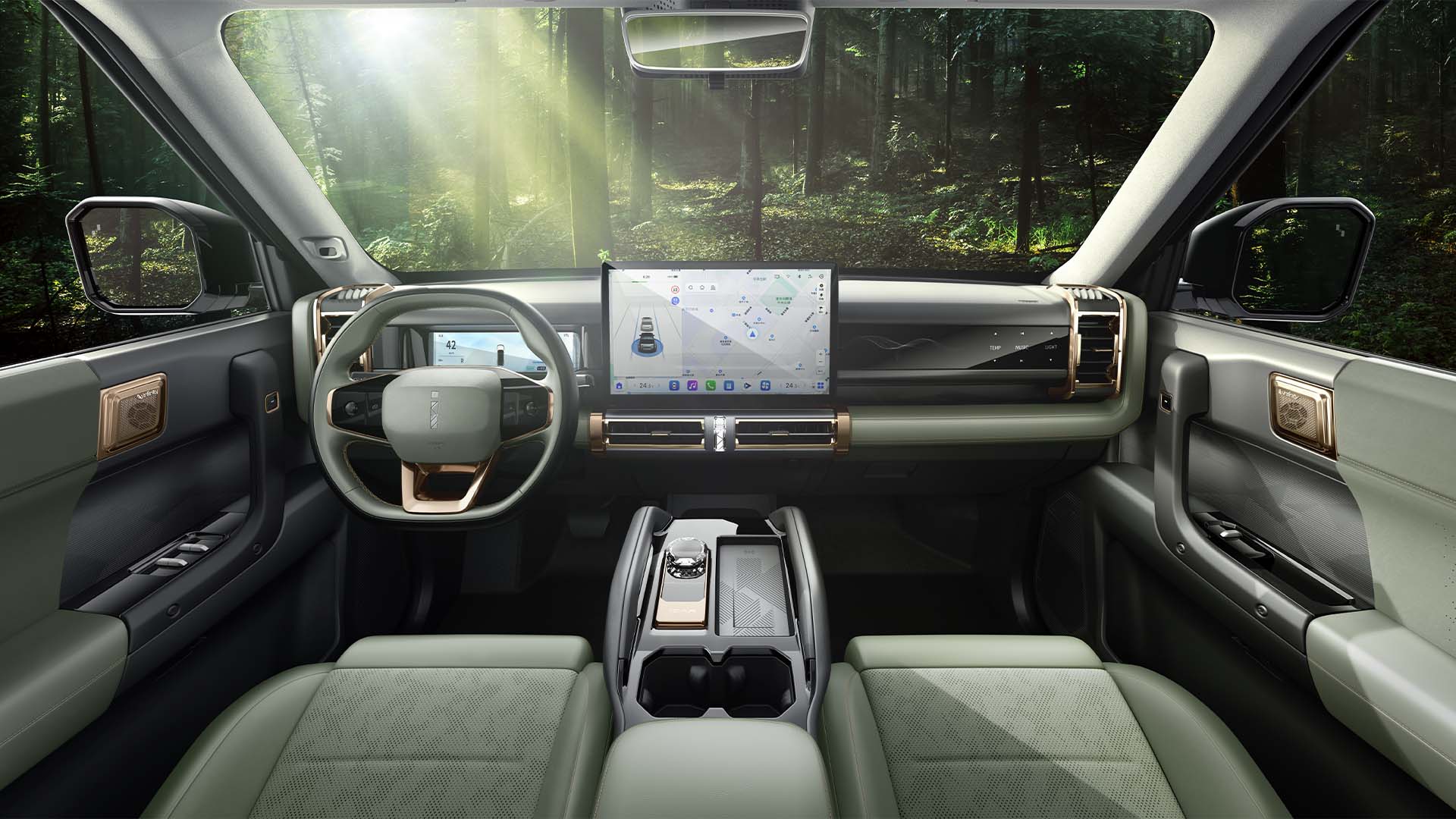What is intelligent four-wheel drive? Imagine a vehicle that not only adapts to the terrain but also anticipates your needs, seamlessly shifting power to the wheels that need it most. This is the essence of intelligent four-wheel drive, a technology that elevates driving to a new level of control and efficiency.
Imagine yourself navigating a winding mountain road, the asphalt slick with rain. With intelligent four-wheel drive, your vehicle becomes an extension of your will, effortlessly maintaining traction and stability as you confidently maneuver through the curves. This isn’t just about power; it’s about precision, about feeling a connection with the road, and knowing that your vehicle is always working in harmony with you.
What is Four-Wheel Drive?

Four-wheel drive (4WD) is a drivetrain configuration that distributes power to all four wheels of a vehicle, allowing for increased traction and stability, particularly on challenging terrains. This system is commonly found in off-road vehicles, SUVs, and some pickup trucks.
Advantages of Four-Wheel Drive
Four-wheel drive offers several advantages over other drivetrain configurations, primarily enhancing a vehicle’s performance and capabilities in various driving conditions.
- Improved Traction: Four-wheel drive systems distribute engine power to all four wheels, providing increased traction on slippery surfaces such as snow, ice, mud, or loose gravel. This allows the vehicle to maintain control and move forward even when one or more wheels lose traction.
- Enhanced Stability: The added traction from four-wheel drive contributes to greater stability, especially during cornering or when navigating uneven terrain. This is particularly beneficial in situations where a vehicle might otherwise lose control due to reduced traction on some wheels.
- Off-Road Capability: Four-wheel drive systems are designed to handle challenging off-road conditions. The increased traction and torque distribution enable vehicles to climb steep inclines, traverse rocky terrain, and navigate through deep mud or sand.
Comparison with Other Drivetrain Configurations
Four-wheel drive systems differ significantly from other drivetrain configurations like front-wheel drive (FWD) and rear-wheel drive (RWD).
- Front-Wheel Drive (FWD): In FWD vehicles, power is transmitted to the front wheels only. This configuration is common in passenger cars and is generally more fuel-efficient but offers limited traction and stability in adverse conditions.
- Rear-Wheel Drive (RWD): RWD vehicles transmit power to the rear wheels. This configuration is often associated with sports cars and trucks, providing better handling and performance on dry surfaces but struggling with traction in slippery conditions.
- Four-Wheel Drive (4WD): 4WD systems provide power to all four wheels, offering superior traction, stability, and off-road capability compared to FWD and RWD systems.
Examples of Vehicles with Four-Wheel Drive
Many vehicles across various segments utilize four-wheel drive systems, including:
- Off-Road Vehicles: Jeep Wrangler, Toyota Land Cruiser, Ford Bronco, Land Rover Defender
- SUVs: Toyota RAV4, Subaru Outback, Honda CR-V, Ford Explorer
- Pickup Trucks: Ford F-150, Chevrolet Silverado, Ram 1500, Toyota Tundra
Types of Four-Wheel Drive Systems

Four-wheel drive (4WD) systems are designed to enhance traction and off-road capability by transferring power to all four wheels. These systems are broadly categorized into three primary types: part-time, full-time, and automatic, each with distinct operating principles, strengths, and weaknesses.
Part-Time Four-Wheel Drive
Part-time four-wheel drive systems are typically found in trucks and SUVs designed for occasional off-road use. These systems are engaged manually by the driver using a lever, switch, or dial, usually located on the dashboard or center console. When engaged, the front wheels are locked to the drivetrain, providing additional traction for challenging terrain. However, it is crucial to disengage the system on paved surfaces, as it can cause drivetrain wear and reduced fuel efficiency.
Operating Principles
Part-time 4WD systems typically employ a transfer case to connect the front and rear axles. This transfer case has a low-range gear that provides increased torque for extreme off-road situations. The engagement process involves shifting the transfer case into 4WD mode, which mechanically connects the front axle to the drivetrain.
Strengths and Weaknesses
- Strengths:
- Increased traction for off-road driving
- Lower cost compared to full-time systems
- Improved fuel efficiency when disengaged
- Weaknesses:
- Limited use on paved surfaces
- Potential for drivetrain wear when engaged on paved surfaces
- Requires manual engagement and disengagement
Full-Time Four-Wheel Drive
Full-time four-wheel drive systems are designed for continuous operation on all surfaces, including paved roads. Unlike part-time systems, full-time 4WD systems automatically distribute power to all four wheels, ensuring consistent traction in various conditions. This is achieved through a sophisticated center differential, which allows the wheels to rotate at different speeds during turns.
Operating Principles
Full-time 4WD systems utilize a center differential that constantly distributes power to all four wheels. The center differential is equipped with a limited-slip function, allowing the system to automatically engage and disengage the front wheels as needed. This ensures optimal traction and stability while maintaining smooth handling on paved surfaces.
Strengths and Weaknesses
- Strengths:
- Continuous traction on all surfaces
- Improved handling and stability
- No need for manual engagement
- Weaknesses:
- Higher cost compared to part-time systems
- Reduced fuel efficiency due to constant power distribution
- Potential for reduced off-road performance compared to part-time systems
Automatic Four-Wheel Drive
Automatic four-wheel drive systems combine the benefits of both part-time and full-time systems. They offer continuous traction on all surfaces while allowing the driver to select a 4WD mode for enhanced off-road capability. These systems utilize sensors to detect wheel slip and automatically engage the front wheels when necessary.
Operating Principles
Automatic 4WD systems use a sophisticated control unit that monitors wheel speed and torque. When the system detects wheel slip, it automatically engages the front wheels, providing additional traction. The system can also be manually engaged for enhanced off-road performance.
Strengths and Weaknesses
- Strengths:
- Automatic engagement for optimal traction
- Improved fuel efficiency compared to full-time systems
- Enhanced off-road capability when manually engaged
- Weaknesses:
- Higher cost compared to part-time systems
- Potential for complex electronic systems
- May require more maintenance than simpler systems
Comparison of Four-Wheel Drive Systems
| Feature | Part-Time 4WD | Full-Time 4WD | Automatic 4WD |
|---|---|---|---|
| Engagement | Manual | Automatic | Automatic/Manual |
| Center Differential | Not present | Present | Present |
| Fuel Efficiency | High (when disengaged) | Moderate | Moderate to High |
| Off-Road Capability | High | Moderate | High |
| On-Road Performance | Limited | Excellent | Excellent |
| Complexity | Low | High | Moderate |
| Cost | Low | High | Moderate |
| Applications | Trucks, SUVs, off-road vehicles | Sedans, SUVs, crossovers | Trucks, SUVs, crossovers |
How Intelligent Four-Wheel Drive Works: What Is Intelligent Four-wheel Drive
Intelligent four-wheel drive (4WD) systems, also known as electronic or smart 4WD, represent a significant advancement in off-road capability and on-road handling. These systems go beyond traditional 4WD setups by utilizing sophisticated sensors and electronic control units to optimize traction and stability in various driving conditions.
Sensors and Electronic Control Units, What is intelligent four-wheel drive
Intelligent 4WD systems rely on a network of sensors to monitor vehicle parameters such as wheel speed, steering angle, throttle position, and yaw rate. These sensors provide real-time data to the electronic control unit (ECU), which acts as the brain of the system. The ECU analyzes this information and makes rapid adjustments to the drivetrain, selectively distributing power to the wheels with the most grip.
Torque Vectoring
Torque vectoring is a technology employed in intelligent 4WD systems that enhances handling and stability by selectively applying more torque to the outer wheels during cornering. This results in a more controlled and precise turn, reducing understeer and improving overall agility.
Electronic Differential Locks
Electronic differential locks, another key component of intelligent 4WD, electronically control the distribution of power between the wheels on the same axle. In situations where one wheel loses traction, the electronic differential lock can engage, transferring power to the wheel with better grip. This helps to maintain forward momentum and prevent wheel spin, improving traction and stability on slippery surfaces.
Components and Information Flow in an Intelligent Four-Wheel Drive System
[Diagram illustrating the components and flow of information in an intelligent four-wheel drive system]
The diagram illustrates the key components and information flow in an intelligent 4WD system. Sensors, such as wheel speed sensors, steering angle sensors, and throttle position sensors, collect real-time data on vehicle parameters. This data is transmitted to the electronic control unit (ECU), which analyzes the information and determines the optimal power distribution to each wheel.
The ECU then sends signals to actuators, such as electronic differential locks and torque vectoring systems, to adjust the drivetrain accordingly. This dynamic and intelligent approach allows the system to adapt to changing driving conditions, maximizing traction and stability.
Benefits of Intelligent Four-Wheel Drive
Intelligent four-wheel drive (i4WD) systems offer significant advantages over traditional four-wheel drive systems, enhancing vehicle performance, safety, and efficiency. By seamlessly engaging and disengaging the drivetrain as needed, i4WD systems optimize traction, handling, and fuel economy across a range of driving conditions.
Impact on Handling, Acceleration, and Braking
Intelligent four-wheel drive systems significantly improve vehicle handling, acceleration, and braking, particularly in challenging conditions.
- Enhanced Handling: By distributing power to the wheels with the most grip, i4WD systems improve vehicle stability and control, especially on slippery surfaces like snow, ice, or wet pavement. This allows for more precise steering and a smoother ride, reducing the risk of skidding or losing control.
- Improved Acceleration: i4WD systems enhance acceleration by distributing power to all four wheels, providing increased traction and reducing wheel slip. This is particularly beneficial when starting from a standstill on surfaces with low friction, allowing for quicker and more controlled acceleration.
- Enhanced Braking: i4WD systems improve braking performance by distributing braking force to all four wheels, increasing stopping power and reducing braking distance. This is especially helpful in emergency situations, providing greater control and reducing the risk of skidding or losing control.
Off-Road Capability and Traction in Slippery Environments
Intelligent four-wheel drive systems excel in off-road situations and slippery environments, providing superior traction and control compared to traditional systems.
- Improved Off-Road Performance: i4WD systems enhance off-road capability by intelligently distributing power to the wheels with the most grip, allowing for better traction and climbing ability on uneven terrain, loose gravel, or mud. This enables vehicles to navigate challenging off-road conditions with greater ease and confidence.
- Enhanced Traction in Slippery Environments: In situations like snow, ice, or wet pavement, i4WD systems provide superior traction by constantly monitoring and adjusting power distribution to the wheels with the most grip. This ensures a smoother, more controlled ride and reduces the risk of skidding or losing control.
Advantages and Disadvantages of Intelligent Four-Wheel Drive
Intelligent four-wheel drive systems offer numerous advantages, but also have some potential drawbacks:
Advantages:
- Improved Fuel Efficiency: By engaging the four-wheel drive system only when necessary, i4WD systems reduce the energy required to power the drivetrain, leading to improved fuel economy compared to traditional systems that are constantly engaged.
- Enhanced Safety: i4WD systems improve vehicle stability and control in various conditions, reducing the risk of accidents and enhancing overall safety. This is especially important in slippery environments where traction is crucial for maintaining control.
- Increased Performance: i4WD systems enhance acceleration, braking, and handling, providing a more responsive and enjoyable driving experience, particularly in challenging conditions.
- Improved Off-Road Capability: i4WD systems excel in off-road situations, providing superior traction and control compared to traditional systems, allowing for greater off-road adventures.
Disadvantages:
- Higher Initial Cost: Intelligent four-wheel drive systems are generally more complex and technologically advanced than traditional systems, resulting in a higher initial purchase price.
- Potential for System Failure: As with any complex system, i4WD systems are susceptible to potential failure, which could affect vehicle performance and safety.
- Increased Maintenance Costs: The complexity of i4WD systems may require more frequent maintenance and repairs, potentially leading to higher long-term maintenance costs.
Applications of Intelligent Four-Wheel Drive

Intelligent four-wheel drive systems have revolutionized the automotive industry by providing enhanced traction, stability, and control in various driving conditions. This technology has found widespread applications across a diverse range of vehicles and industries, significantly impacting vehicle performance, safety, and efficiency.
Vehicles Utilizing Intelligent Four-Wheel Drive Systems
The use of intelligent four-wheel drive systems is prevalent in various vehicle types, each tailored to specific driving needs and terrains.
- Passenger Vehicles: Intelligent four-wheel drive systems are increasingly common in passenger vehicles, particularly SUVs, crossovers, and sedans. These systems enhance traction and stability on slippery surfaces, such as snow, ice, and wet roads, providing drivers with increased confidence and safety.
- Off-Road Vehicles: Intelligent four-wheel drive systems are essential for off-road vehicles, such as trucks, SUVs, and ATVs. These systems allow vehicles to navigate challenging terrains with ease, providing superior traction, ground clearance, and articulation.
- Commercial Vehicles: Intelligent four-wheel drive systems are utilized in commercial vehicles, including trucks, vans, and buses, to enhance traction and stability in demanding conditions. These systems improve fuel efficiency, reduce wear and tear on tires, and enhance safety for drivers and passengers.
Applications of Intelligent Four-Wheel Drive in Various Industries
Intelligent four-wheel drive technology has found diverse applications in various industries, transforming vehicle capabilities and performance.
- Automotive Industry: Intelligent four-wheel drive systems are a standard feature in many modern vehicles, enhancing safety, performance, and fuel efficiency. These systems allow for better traction and control in various driving conditions, improving driver confidence and overall vehicle performance.
- Off-Road Industry: Intelligent four-wheel drive systems are essential for off-road vehicles, allowing them to navigate challenging terrains, such as rocky trails, mud, and sand. These systems provide superior traction, ground clearance, and articulation, enabling vehicles to overcome obstacles and reach remote locations.
- Commercial Industry: Intelligent four-wheel drive systems are used in commercial vehicles, such as trucks, vans, and buses, to enhance traction and stability in demanding conditions, such as hauling heavy loads, navigating slippery surfaces, and operating in extreme weather conditions.
Intelligent Four-Wheel Drive and Autonomous Driving
Intelligent four-wheel drive technology plays a crucial role in the development of autonomous driving systems. By providing enhanced traction, stability, and control, intelligent four-wheel drive systems enable autonomous vehicles to navigate challenging driving conditions with greater precision and safety.
- Improved Traction and Stability: Intelligent four-wheel drive systems provide enhanced traction and stability, allowing autonomous vehicles to maintain control on slippery surfaces, such as snow, ice, and wet roads. This is crucial for safe navigation in various weather conditions.
- Precise Vehicle Control: Intelligent four-wheel drive systems enable autonomous vehicles to precisely control their movements, even in challenging driving conditions. This allows for smoother and more predictable driving, enhancing safety and passenger comfort.
- Enhanced Safety Features: Intelligent four-wheel drive systems can be integrated with other safety features, such as lane departure warning, automatic emergency braking, and adaptive cruise control. This combination of technologies enhances safety and reduces the risk of accidents in autonomous vehicles.
Evolution of Intelligent Four-Wheel Drive Technology
Intelligent four-wheel drive technology has undergone significant advancements throughout its history, leading to more sophisticated and efficient systems.
- Early Systems (1900s-1950s): Early four-wheel drive systems were primarily mechanical and required manual engagement. These systems were often bulky and inefficient, but they provided essential traction in challenging conditions.
- Electronic Control Systems (1960s-1980s): The introduction of electronic control systems revolutionized four-wheel drive technology, enabling more precise and efficient power distribution. These systems allowed for automatic engagement and disengagement of the four-wheel drive system based on driving conditions.
- Intelligent Systems (1990s-Present): Modern intelligent four-wheel drive systems utilize advanced sensors, algorithms, and actuators to continuously monitor driving conditions and distribute power to the wheels as needed. These systems are highly sophisticated and provide optimal traction and stability in various driving scenarios.
As we journey deeper into the world of intelligent four-wheel drive, we discover a technology that is not only about conquering challenging terrains but also about enhancing our connection with the road. It’s about pushing the boundaries of what’s possible, and embracing the future of driving, where technology and intuition work together to create an experience that is both exhilarating and empowering.
General Inquiries
What are the main differences between intelligent four-wheel drive and traditional four-wheel drive systems?
Intelligent four-wheel drive systems utilize sensors and electronic control units to distribute power to the wheels in real-time, based on road conditions and driver input. Traditional four-wheel drive systems typically engage all wheels simultaneously, without the same level of dynamic control.
Is intelligent four-wheel drive only for off-road vehicles?
While intelligent four-wheel drive is particularly beneficial in off-road environments, it’s increasingly common in everyday vehicles. It enhances traction and stability on paved roads, especially in slippery conditions.
How does intelligent four-wheel drive improve fuel efficiency?
By selectively engaging the wheels that need power, intelligent four-wheel drive systems can reduce unnecessary power consumption, contributing to better fuel economy.